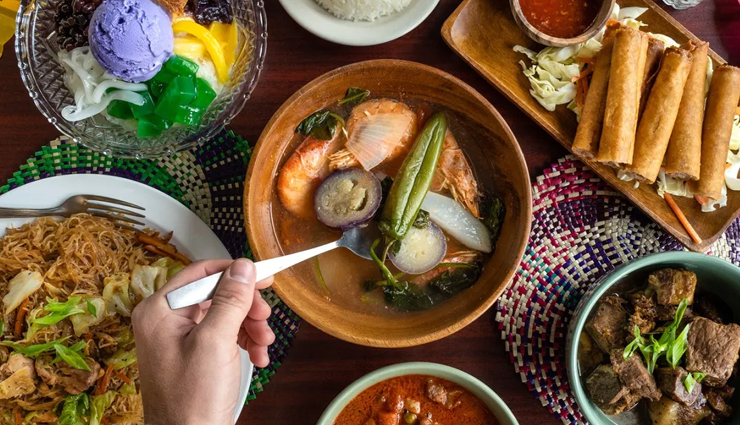8 Interesting Facts About Filipino Cuisine You Didn't Know
By: Pinki Mon, 25 Jan 2021 2:37:23

Filipino cuisine is often tagged as “the next big thing” in the culinary world. Drawing inspiration from many international influences, Filipino food is created to suit local tastes – resulting in an altogether fascinating cuisine.
Filipino food is a mix of Asian and Western influences transformed through local cooking techniques. Boasting proud indigenous flavors, rich traditions and eating practices unique to the country, Filipino cuisine is distinct, delicious and unlike anything you’ll have tasted elsewhere. Here are 8 things to know about Filipino cuisine.

# It’s never a meal without rice
Rice (particularly white rice), is considered the ultimate staple in Filipino food. It is present in every household and is more than likely part of every Filipino’s meal – breakfast, lunch and dinner. Because of its plain, starchy flavor, it pairs well with a lot of salty and sour local dishes. Filipinos love rice so much that they would consume it whether it’s traditionally cooked white rice (kanin), burnt rice (tutong), left-over rice (bahaw) or fried rice (sinangag). Restaurants and fast food chains catering to Filipinos based out of the country make sure that rice is always part of their menu. Sarap.
# Dipping sauces are part and parcel of Filipino cuisine
Although rice complements any Filipino dish, dipping sauces (served on the side) make your munch extra flavorful. The most common dipping sauces are soy sauce and calamansi (mixed together), fish sauce (patis), and spiced vinegar. Fried fish is especially more satisfying with one of these on the side. Sometimes, it’s the sauce that completes the dish: For instance, Kare-kare (peanut-based beef stew) is always paired with bagoong (shrimp paste). Most importantly, there are no rules for creating dipping sauces and no one way to mix them. Most Filipinos would claim they can’t eat without their favorite sawsawan (dipping sauce).

# Duck embryos are a delicacy
You’ve probably come across the notorious balut on an episode of Fear Factor (which would make many Filipinos scratch their heads – it’s delicious). This hard-boiled duck embryo, usually between two to three weeks old, makes for a tasty snack. Depending on its incubation period, the partially developed duck embryo may have features such as the beak, eye socket, or feathers. It’s best served warm and enjoyed with a dash of rock salt or vinegar. While it may look vile to those with weaker constitutions, it’s considered a healthy addition to your diet as it’s loaded with protein and calcium.
# And so are the ‘extra’ parts of animals
In addition to the infamous balut, foreigners are often surprised to learn that locals include ‘unconventional’ animal parts in their cooking. That’s because Filipinos are a resourceful bunch, making sure that nothing goes to waste. There are recipes for almost every part of animal anatomy: Pig’s leg is cooked into the well-loved Filipino dish called Crispy Pata, while its head becomes tasty appetizers like sisig or dinakdakan. Chicken intestines are barbecued and sold on the streets as isaw. Even pig blood is the main ingredient in dinuguan, a bloody delicious stew.

# Pork is king
In the Philippines it’s rare to find purely-vegetable dishes, whether in households or local restaurants. Even if you order chop suey or pinakbet, these mixed vegetable dishes will often have pork in the mix. Filipinos are meat lovers through and through. Nowhere is this more apparent than in Cebu’s famous lechon, roast suckling pig with crispy skin that people travel far and wide to taste. You’ll also come across different variations of classic dishes with a piggy twist, such as pork sinigang, pork sisig, and the country’s national dish – adobo.
# Filipino food draws inspiration from multiple cultures
Filipino cuisine is very complex, heavily influenced by the country’s former colonizers and its neighboring Asian countries. Because of this, Filipino food has been shaped by the Chinese, Spaniards, Indians, Japanese, and a whole plethora of Western influences. For instance, the country’s pancit (noodles) and lumpia (spring rolls) were influenced by early Chinese settlers in Manila, taking on a very Filipino life of their own. Additionally, the Filipino-favorite dessert halo-halo was introduced by the Japanese! Apart from these strong cultural influences, the preparation of Filipino dishes vary per region and there’s at least one known specialty per locality.

# Filipinos can’t call it a day without having merienda
Since rice is the country’s staple meal (which is very easy to digest), Filipinos often find themselves hungry two-to-three hours after eating. People often have snacks (merienda) in the late morning, and another in the afternoon. Popular Filipino snacks can be pretty much anything (pastries, rice cakes called kakanin, fried bananas, pancit) as long as it does not constitute white rice (which gives you a lot of options!). The merienda tradition dates back to the Spanish era, when locals living in rural areas had breakfast as early as 4 a.m. to work in the fields and needed to grab a bite in-between meals.
# You eat with your hands and never let the food wait
While it’s uncommon to see people eating with their hands in the West, in the Philippines it’s tradition. Kamayan, which is the act of eating food with your hands, is viewed by Filipinos as the best way to enjoy a meal – your digits are dextrous enough to scoop and mix all the flavors, after all. But if you don’t feel like using your hands, you can also eat food Filipino-style – no knives and only a fork and spoon. Another customary tradition among Filipinos is to never let the food wait. Here, meal time is a sacred ritual and so everyone (especially families) must eat together and share everything that’s laid out on the table.



-1713979511-lb.jpg)

